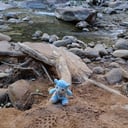What is Ectrodactyly?
Ectrodactyly, split hand, or cleft hand involves the deficiency or absence of one or more central digits of the hand or foot and is also known as split hand malformation.The hands and feet of people with ectrodactyly are often described as "claw-like" and may include only the thumb and one finger. The central ray of the hand is affected and usually appears without proximal deficiencies of nerves, vessels, tendons, muscles and bones in contrast to the radial and ulnar deficiencies. The cleft hand appears as a V-shaped cleft situated in the centre of the hand.
The digits at the borders of the cleft might be syndactyly, and one or more digits can be absent. In most types, the thumb, ring finger and little finger are the less affected parts of the hand.The incidence of cleft hand varies from 1 in 90,000 to 1 in 10,000 births depending on the used classification. Cleft hand can appear unilateral or bilateral, and can appear isolated or associated with a syndrome.
A large number of human gene defects can be the cause of ectrodactyly. The most common mode of inheritance is autosomal dominant with reduced penetrance. In the clinical setting these genetic characteristics can become problematic and make predictions of carrier status and severity of the disease impossible to predict.
More Info:
en.m.wikipedia.org


